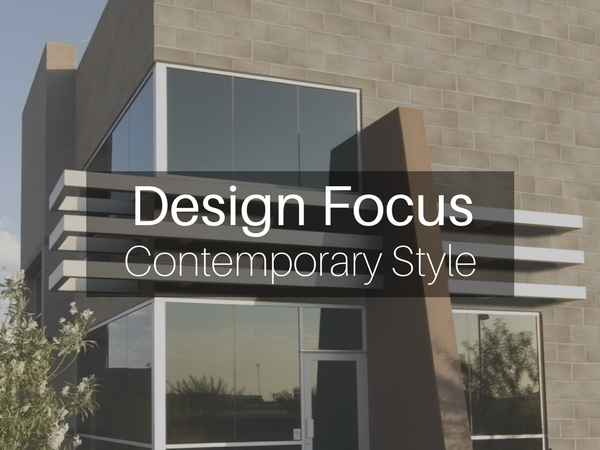
Advances in every field of human endeavor have progressed at an accelerated rate throughout the 20th century, and into our current millennium. These advances heralded a period of modernity, characterized by a rebellion against traditional forms of expression, including architectural design.
Contemporary is a term used to identify topical trends and is sometimes used interchangeably with being Modern. Contemporary style, however, tends to reflect designs that are current and fluid, while Modern style extends over periods of time, usually with a more specific aesthetic. Both converge at clean, simple lines and a ‘less is more’ concept unlike many of its predecessors.
Contemporary style draws from Scandinavian minimalist design with its open floor plans, clean lines and streamlined furnishing, merged with the bold geometric, asymmetrical floor plans of styles like Art Deco and Futurism. Although Contemporary and Modern are intertwined, our focus will be specifically on the former, highlighting its features while acknowledging the influence of the latter.
DEFINING CONTEMPORARY STYLE
Unlike Modern architecture that is defined by mid century building style, Contemporary architecture focuses on present day building styles. It became popular in the 1970s and blended with many different styles in its inception before finally creating its own niche. Contemporary is defined as belonging to or occurring in the present. Simply put, it refers to things ‘of the moment.’ But if the style constantly shifts with moments, how does it maintain its relevance? It does so by being easily transferable to other styles due to its fluid nature. In that, as a building design changes it is being influenced by evolving preferences and tastes which will eventually and inherently create a contemporary space. This does not mean modern elements are discarded. In fact, Contemporary spaces often do incorporate modern elements and pieces.
Almost all Contemporary designs share the common elements of oversized windows, bold shapes and minimal use of colour and textiles. These elements give the space an abundance of light and a sense of airiness. Current focus on a more eco-friendly, energy efficient way of life has had an effect on the design style. It is becoming common to see plants and solar panels adorning buildings aiming to decrease our carbon footprint and improving air quality. Other sustainable materials like bamboo are often used as flooring and natural granite for countertops.
Interestingly, Contemporary styles also tap into design history and freely borrows from their predecessors, mixing and matching to create unique looks and feels. The combination of past and current elements results in a warm and inviting space. This is emphasized by the connection between the indoor and outdoor areas where clean, simple lines meet outdoor kitchens, barbecues and fireplaces.
INSIDE CONTEMPORARY
Unlike traditional spaces, Contemporary interiors are bold and emphasize current trends. The emphasis on line and form gives the style its energy. Like Modern style, the less is more philosophy applies, but with a few noticeable differences. The lines and colours are softer and an abundance of natural light and air flowing through the space makes it airy and calming.
Although every design borrows from and influences each other, the oversized windows, irregular massing, clean lines and minimal ornamentation gives more room for experimentation and flow. Windows in Contemporary spaces are usually abundant and undressed to allow all that light and air in. Design serves a utilitarian purpose, not necessarily a decorative one, meant to connect with the surrounding landscape.
Its asymmetry and strong geometric shapes, as well as its structural furniture, easily identify the style. Light-coloured, smooth surfaces are a standard feature in Contemporary homes. To achieve the Contemporary feel, keep accessories simple. Pieces are chosen to enhance the space rather than distract from it. Highlighting the structure of the space is a design component of its own.
Everything inside a Contemporary home screams minimalism. From the texture to walls to flooring, the style normally gravitates towards neutral tones. Neutral colours like cream, beige, brown and gray allow the lines and shapes to take centre stage. Brighter colours are allowed, but only minimally. For a pop of colour, Contemporary designers may incorporate an accent wall or a bold piece of furniture. Contemporary floors are bare and finished in wood, stone, cement or laminate, with an occasional rug that compliments the clean lines of the space. Texture may be added with neutral stone veneers. Overall, the Contemporary space does not require much trimming or accessorizing. There are no extraneous additions such as columns, mouldings or the excessive use of colour or textiles.
CANADIAN CONTEMPORARY
Canadian architecture and design have been heavily influenced by Contemporary architecture in this millennium. The interiors and designs capture the spare, clean lines of the Modernist movement. This aesthetic change signals a movement towards a more sophisticated style of building with Contemporary technology and materials, and positive environmental goals. The design style has sprung up in mostly urban centres like Vancouver, Montreal and Toronto. Anywhere Contemporary thought flourishes, so will the impact on how Canadians live.
CONTEMPORIZING YOUR HOME
Introducing contemporary elements to your home is quite simple. Because the style is ‘of the moment’, by adding – or better yet, subtracting – components, your goal can be achieved. Consider using low profile manufactured stone in certain areas for a warm feel that cuts through the bare aesthetics.
Outdoor fireplaces and kitchens would also benefit from manufactured stone. In a Canadian home, Contemporary or otherwise, the fireplace is still typically the gathering place for friends and family. Pro-Fit® Modera™ Ledgestone or Hewn Stone™, or the brand new Pro-Fit® Terrain™ Ledgestone, manufactured stone veneers would be the perfect accent for an area like that; functional, clean and attractive. For the finishing touches, add trims and decorative details like lintels and hearthstones. Keep in mind though that less is more, so with any adjustment, maintain the minimalist appeal.